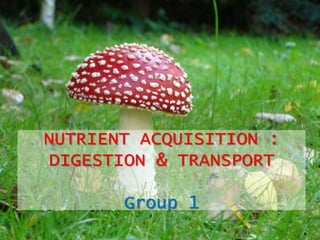Fungal Nutrient Acquisition: Disaccharides and Cellulose
- 1. NUTRIENT ACQUISITION : DIGESTION & TRANSPORT Group 1
- 2. DISACCHARIDES Examples: Sucrose, maltose and cellobiose
- 3. May be transported into fungus:  Intact or  Hydrolyzed before being transported. • E.g., In S. cerevisiae, sucrose was converted to glucose and fructose at the cell surface and the monosaccharides were transported.
- 4. • Isolated cell walls of S. cerevisiae contained most of the invertase. • Invertase was solubilized by treated with snail digestive enzyme in mannitol. • Protoplast were unable to ferment sucrose, but could ferment glucose • Maltose was not located in wall, but retained in the protoplast. • Yeast cannot ferment maltose unless the have been grown on maltose.
- 5. CELLULOSE Structure : microfibrillar substance of linear molecules packed into crystalline arrays interspersed with amorphous regions. •Non- ordered structure •Helps in β-linkage to adapt to microenvironment Native cellulose : Insoluble : Comminuted to produce fine particulate suspension
- 6. Modified, soluble cellulose derivatives Carboxymethyl cellulose ( CMC) and Hydroxyethyl cellulose ( HEC ) - Thickener in Food Umbelliferyl cellodextrins • Chromogenic substances • Enzyme activities measured based on the colored products
- 7. Cellobiohydrolase Endoglucanases Digest ONLY Amorphous Region Crystalline Arrays and Amorphous Region
- 8. • CBHI and EGI have greater than 50% nucleotide sequence similarity and about 45% amino acid sequence similarity. • CBHII and EGIII were unrelated to each other or the first pair. Two reasons for the expression of the genes for the enzymes in Saccharomyces cerevisiae: • Since S. cerevisiae has no known exocellular cellulases, expression of the genes individually resulted in single-enzyme activities with no cross contamination. • Since cellulose substrates are highly variable, conversion of cellulose to glucose may not be optimal with the native mix from Trichoderma reesei.
- 9. • Expression of the four cloned cellulase genes of T. ressei in S. cerevisiae succeeded by using cDNA clones from the mRNAs to eliminate the introns that were not correctly spliced by yeast, and by providing suitable yeast promoters. • The recombinant enzymes from S. cerevisiae were active toward the natural substrates, barley β-glucan and lichenin, and several artificial substrates. • The specific activity and binding of the recombinant CBHII were reduced in comparison with the natural enzyme, suggesting that the hyperglycosylation affected activity.









